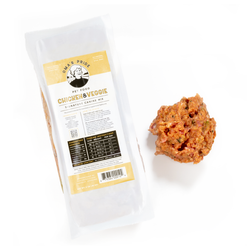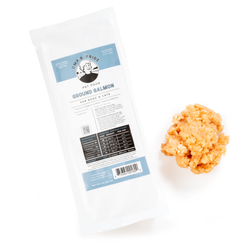Beef Hearts for Dogs: Sourcing, Benefits, & How to Feed
If you’re a raw feeder, you know how important organs, muscle meat, and even hearts are for your pup’s well-being.
Hearts (commonly beef, chicken, or even pork) are muscular organs fed as muscle meat in a BARF raw feeding model. While some humans might be reluctant to eat animal hearts, dogs eat them up with glee.
Organ meats are essential to your dog’s diet because they are nutrient-dense for health and longevity. In particular, incorporating beef hearts into a balanced dog diet can help strengthen blood flow, improve cell and immune function, and more.
Continue reading to discover more about beef hearts for dogs, including where to purchase them, their primary benefits, general guidelines, and a nutritional breakdown.

Where to purchase beef hearts for dogs and cats
Beef hearts are often sold raw or freeze-dried. They can be purchased as a single ingredient or as part of a blend.
For best results, source raw hearts from an online pet retailer, a local natural pet store, a trusted butcher, or a raw co-op. Ideally, try to find human-grade meat from grass-fed animals.
While you can purchase hearts from a grocery store and cook them, this is not the optimal form for canines (carnivores). Why? Applying high heat to hearts cooks out the live enzymes, beneficial bacteria, and other raw nutrients that are vital for your pup.
Buy raw beef hearts from Oma’s Pride
If you’re looking for the highest quality beef hearts (that can be delivered to your door!), look no further than Oma’s Pride. All of our beef heart products are:
- Sourced, processed, and produced exclusively in the United States
- Made without any fillers, antibiotics, additives, preservatives, corn, soy, sugar, by-products, or anything you can’t pronounce
- Made in small batches in a USDA kitchen from human-grade, grass-fed cattle
- 100% raw (no HPP)
- Rich in B vitamins, iron, and zinc
Check out all the products to choose from below!
Explore Products
Frozen raw
We offer a few frozen raw products containing beef hearts, from complete meals to organ blends.
- Option 1: Buy Ground Beef Organ Meat (1 lb) for both dogs and cats. The ingredients are simple: ground beef heart, kidney, and liver.
- Option 2: Take the guesswork out of raw feeding with our Woof Complete Beef Recipe for dogs only. This is a complete meal that meets and exceeds AAFCO nutritional minimums for a balanced diet.
- Option 3: Purchase our Beef & Veggie Signature Mix. Our signature mixes are designed for supplemental feeding to dogs only. Ingredients include beef meat, heart, kidney, liver, bone, and select vegetables.
Using raw beef hearts in a BARF model
General ratio guidelines following the BARF (biologically appropriate raw food) model:
- 70% muscle meats (tongue, lungs, hearts, connective tissues, tripe, meat, and more)
- 10% raw edible bones
- 10% liver and secreting organs (kidney, brain, pancreas, and more)
- 7% vegetables
- 2% nuts or seeds (hemp hearts, pumpkin seeds, flax seeds, and more)
- 1% dog-safe fruits
Although beef hearts fall into the 70% category, you cannot feed them exclusively because of their richness; dogs also need other nutrients outside of hearts to achieve a balanced diet.
A good rule of thumb is that hearts should make up 5-10% of your pet’s daily food intake. Keep in mind that this is just a starting point. Some raw feeders successfully feed up to 15% heart in the diet per day, depending on their dog’s needs.


How to feed beef hearts to your dog
Like any single raw element, how you feed it depends on your purpose. For example, you can’t give your dog a meal of 100% beef heart, but you can incorporate it into the overall diet.
Both dogs and cats can eat raw beef hearts as a nutritional topper, training treat, or single ingredient inside a larger meal (like a Beef & Veggie Signature Mix).
You can feed freeze-dried hearts immediately or crumble them up first. Thaw raw hearts from frozen in the refrigerator for about 24 hours before serving.
If your pup hasn’t eaten beef heart before, consider introducing it slowly to see how they react. Feeding too much heart can cause diarrhea, so closely monitor quantities. You can increase the amount once your pup is doing well with solid stools.
Quick tip! Giving your dog something to soothe the GI tract when introducing a new food, like pumpkin or spinach puree, ginger, bone broth, or Digestive Performance, is always a good idea.
The main benefits of beef hearts
Beef hearts for dogs are a rich source of B vitamins, collagen, omega-3 fatty acids, taurine, and iron. Taurine supports your dog’s heart strength and blood flow; other elements, like collagen, help the joints with mobility, which is particularly beneficial for aging pets.
Additionally, beef hearts' omega-3 fatty acids and collagen promote shiny, non-flaky skin and coats. Beef hearts can also reduce general inflammation and allergenic symptoms because they contain Coenzyme (CoQ10) with fatty acids.
You can also feel good feeding nutritious parts like the heart, lung, kidney, and others that might otherwise be wasted or discarded. It’s a win-win: your dog will love organ meats, and you can do your part to reduce waste when you feed them!

Other vitamins and minerals in beef hearts
Beef hearts are a lean protein full of essential vitamins and minerals like elastin, selenium, phosphorus, and fat-soluble vitamins (A, D, E, and K).
Although these hearts are a relatively small part of the animal, they are a large superfood for your pet. You can be confident you're giving them the absolute best by including beef hearts in your dog's bowl.
Other vitamins and minerals in beef hearts include:
Zinc
Three ounces of beef heart contains about 2.4 milligrams of zinc, which supports the thyroid and immune system. With proper levels of zinc in your pup's diet, they will retain the ability to fight infections and illness.
Iron
Overall, iron plays a crucial role in boosting collagen production, creating and maintaining red blood cells, and supporting various enzyme functions. Three ounces of beef heart contains about 5.4 milligrams of iron in it. Providing iron-rich foods to your dog ensures that they remain energetic and vibrant throughout their life.
B vitamins
B vitamins, including niacin, cobalamin (B12), pyridoxine, thiamine, and folate, play a crucial role in various bodily functions in your dog. These vitamins support cognition, metabolism, and digestion, among other functions.

Is it okay to feed my dog raw beef heart?
In short, yes! You can feed your dog raw beef heart as a part of a balanced diet. Dogs are carnivorous canines well-adapted to eat raw meat. Dogs have short GI tracts, sharp teeth, tight digitation of molars to tear and rip meat, and highly acidic stomachs.
While we might see our pups as cute and fluffy (which, of course, they are!), they are taxonomically classified as carnivores in Carnivora. This classification means their optimal diet is different from that of a human.
Keep in mind that if you’re not comfortable with frozen raw yet, you can also try freeze-dried raw to keep everything a little less messy (and bloody). Freeze-dried has all of the benefits of raw with less of a mess.
When feeding any raw food, always follow safe food handling techniques like not leaving meat out at room temperature for too long and washing hands and surfaces thoroughly after touching meat.
Related: How Oma’s Pride addresses raw food safety with bacteriophaging


Frequently asked questions
How much beef heart can I feed my dog?
We recommend feeding your dog beef hearts as 5-10% of their daily food intake. Too much beef heart can cause diarrhea or an upset stomach because of its richness, so don’t feed exclusively heart.
Can dogs eat beef heart every day?
Yes, dogs can eat beef heart every day if it’s incorporated into a larger, complete meal. Beef hearts help meet your dog’s muscle meat minimum requirements for the day, along with other essential vitamins, minerals, and protein.
Is beef heart better than chicken heart for dogs?
Both beef hearts and chicken hearts are excellent for dogs and relatively easy to source for raw feeders. Beef hearts contain less fat, higher levels of B vitamins, and more protein. Chicken hearts contain more calories per ounce and are cheaper to purchase.
Leave a comment
Your email address will not be published. Required fields are marked with *




















